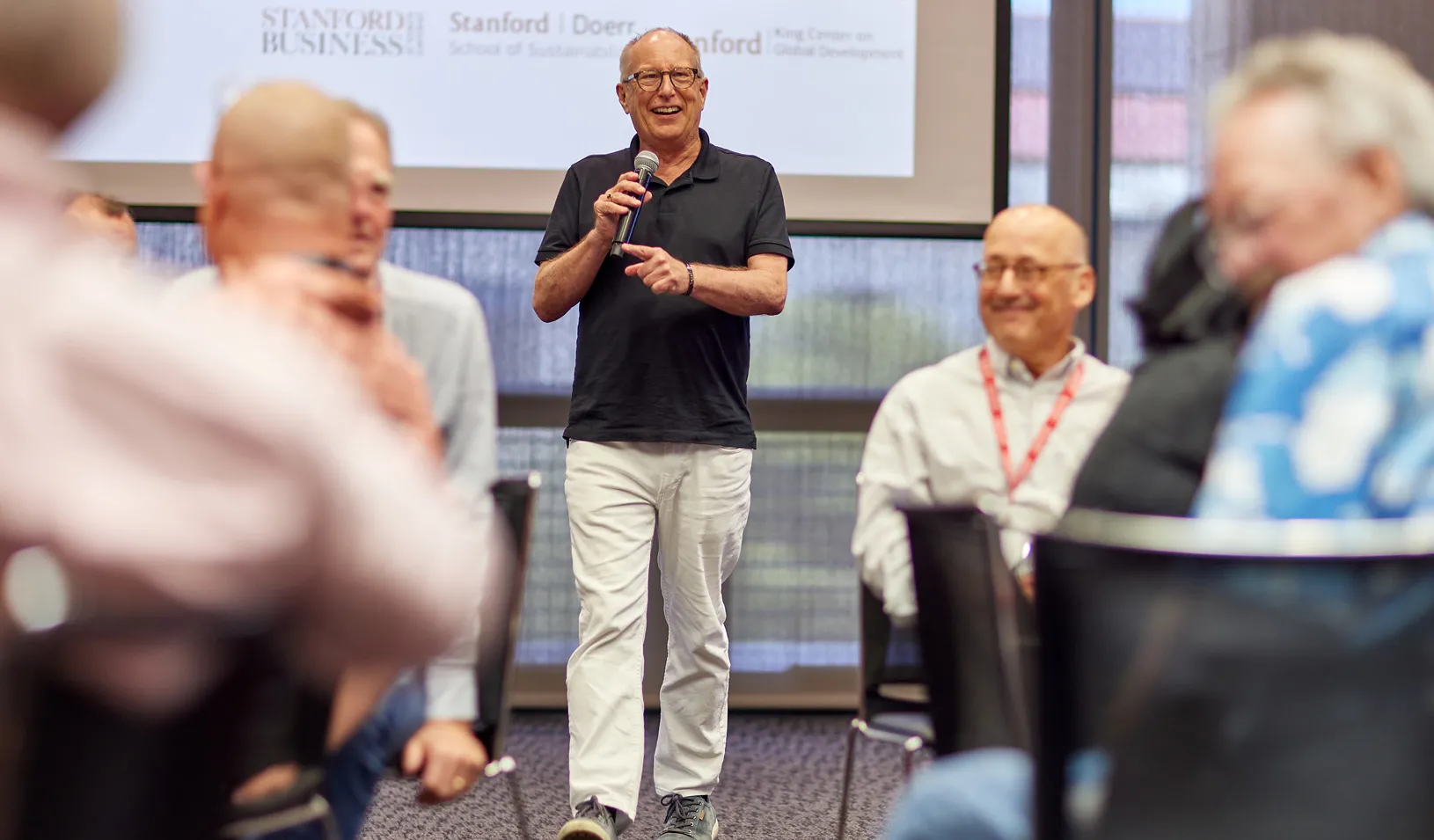
Professor William P. Barnett welcomes attendees to the inaugural Stanford Sustainability Summit. | Nancy Rothstein
Maria Inez Jaramillo and Miryam Yefi Jaramillo, members of the indigenous Mapuche people of Chile, are determined to preserve their way of life. Large corporations in Chile are planting monocultural trees that are invading the landscape, destroying biodiversity, and leaving chemical waste in watersheds. Maria and Miryam are working to develop business practices that will improve biodiversity outcomes and preserve fish habitats for increased food security for the Mapuche. Their story was just one of many presented at the inaugural Stanford Sustainability Summit.
Sustainability advocates, business owners, government officials, and community leaders from across the globe convened on the Stanford campus on July 8 and 9 to share ideas, recount success stories, and express enthusiasm and an insatiable appetite to address the world’s growing sustainability challenges.
Forty-eight attendees from 22 countries attended the event and brought with them solutions, ideas, needs, and a desire to collaborate, according to summit co-organizer and moderator William P. Barnett.
Barnett, chair of the Department of Environmental Social Sciences at the Stanford Doerr School of Sustainability, is also the Thomas M. Siebel Professor of Business Leadership, Strategy, and Organizations at Stanford GSB, a professor at the Stanford Doerr School of Sustainability, and a senior fellow at the Stanford Woods Institute for the Environment. He wants to facilitate the development of solutions to the global sustainability crisis and sees progress despite the slow pace at which many nations are moving to bring about change. “We are in the middle of a sustainability revolution,” Barnett says. “It’s happening right now, and the revolutionaries of the sustainability revolution are not waiting. They are taking action now.”
Attendees represented non-profits, NGOs, start-ups, established companies, and the public sector. “We did not evaluate who we invited based on the size of their hat or their title or the size of their organization,” Barnett says, describing attendees as “changemakers.” “We invited them on the basis of how innovative they are.” Attendees were selected because of their exposure to Stanford through previous in-country visits by Barnett and others in the Doerr School, which co-sponsored the event with Stanford GSB and the Stanford King Center on Global Development. The event was co-organized by Marissa Mendoza, associate director of the Stanford Initiative on Business and Environmental Sustainability.
The summit had two major goals, according to Barnett. “One was to highlight and showcase amazing changemakers so that Stanford students, faculty, and alumni can be exposed to them,” he says. “The second was to provide a context to generate new innovation, having an ongoing relationship with these organizations around innovative ideas.”
Generating ideas
Among the exercises at the summit was “Wouldn’t it be great if …,” in which participants were divided into groups to develop ideas to help solve the world’s sustainability challenges – regardless of perceived barriers. Possible solutions included granting voting rights to people 16 to 25 years old in all countries and developing a methodology for presenting the actual cost of climate impacts to governments and industry.
The exercise’s goal was to enable far-reaching thinking and capitalize on the summit attendees’ divergent perspectives and attributes. It also generated specific actions toward fulfilling these ideas over the next year.
“One of the things we know about innovation is that when you combine unlikely partners, you get some of the most amazing innovations that tend to be ones we never would’ve predicted,” says Barnett. “In that spirit, we grouped organizations and changemakers by design.”
Stanford faculty and students also attended with the aim of developing relationships that could lead to further dialogue. “This allows our students and faculty to learn about these changemakers first-hand,” says Barnett. “They presented so that faculty and students here at Stanford could see what they’re doing. We provided them a stage so that their good work on sustainability could be understood by the world.”
In addition to the work being done in Chile to preserve the environment of the Mapuche, attendees learned of Netafim, an Israeli company known for its drip irrigation systems that allow for growing more food with less water. The innovation enables agricultural businesses to thrive while also producing much less methane, a byproduct of typical flood irrigation systems. “These changes are making the world more sustainable now,” Barnett says.
Beyond the summit
Barnett already has plans for a 2025 gathering as well as a way of connecting participants. “We’re creating an online platform and we’re going to have in-person gatherings of the changemakers as they continue to turn these ideas into real projects,” he says. “And, we’ll be involving Stanford students as interns. We’re also designing some kind of onsite study abroad where Stanford students can, as part of their studies, engage with these changemakers. This continues to push Stanford researchers and Stanford education and teaching into the world.”